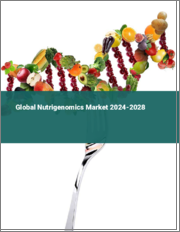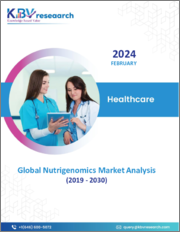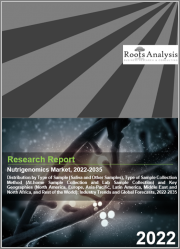
|
시장보고서
상품코드
1541345
영양유전체학 시장 보고서 : 제품 유형, 용도, 최종사용자, 지역별(2024-2032년)Nutrigenomics Market Report by Product, Sample Type, Application, End User, and Region 2024-2032 |
||||||
영양유전체학 세계 시장 규모는 2023년 12억 1,260만 달러에 달했습니다. 향후 IMARC Group은 2032년까지 시장 규모가 30억 4,970만 달러에 달해 2024년부터 2032년까지 10.47%의 연평균 성장률(CAGR)을 기록할 것으로 예측했습니다.
뉴트리제노믹스라고도 불리는 영양유전체학은 영양, 건강, 인간 유전체의 관계를 분석하는 의학의 한 분야입니다. 유전자와 식습관의 상관관계를 이해하고, 유전자와 식습관이 사람의 건강과 암, 심혈관질환(CVDs), 비만과 같은 질병의 발병 위험에 미치는 영향을 이해하는 데 초점을 맞추고 있습니다. 영양유전체학은 노화와 질병에 대한 소인을 감지하고 유전자형에 따라 개인화된 식단과 영양 계획을 세우는 데 도움이 됩니다. 또한, 주요 영양소와 미량영양소의 독성 및 안전성 프로파일을 이해하고 식습관 관련 질병을 예방하는 데도 도움이 됩니다. 이 외에도 영양유전체학 검사는 일반적으로 혈액, 볼 물티슈, 타액 등의 샘플을 채취하여 검사하는 것이 일반적입니다.
영양유전체학 시장 동향:
전 세계적으로 비만 유병률이 증가하고 있으며, 시장 전망은 밝습니다. 영양유전체학은 개인의 유전자 수준을 이해하는 데 도움이되며, 이를 바탕으로 적절한 영양 식단을 제공함으로써 비만을 더욱 감소시킬 수 있습니다. 또한, 건강과 피트니스에 대한 소비자의 성향이 증가하고 특히 운동 선수와 피트니스 애호가들 사이에서 개인화 된 영양 제품에 대한 수요가 증가함에 따라 시장 성장을 주도하고 있습니다. 이와는 별도로 주요 기업들은 연구 개발(R&D) 활동에 적극적으로 투자하여 인간 유전학을 발견의 기초로 삼아 혁신적인 의료 및 잠재적 치료법을 도입하고 있습니다. 또한, 약해진 면역 체계를 강화하고 콜레스테롤 화합물 섭취를 줄이는 등 특정 유전자 프로필에 맞는 맞춤형 식품을 개발하는 데 주력하고 있으며, 이는 시장 성장을 촉진하고 있습니다. 또한, 비타민 D, K, 엽산, 철분 빈혈, 저칼슘혈증, 골연화증, 건피증, 괴혈병, 페라그라, 구루병과 같은 영양 결핍증이 증가하고 있는 것도 시장 성장을 촉진하는 요인입니다. 이 외에도 대중의 건강 인식 증가, 심장병, 당뇨병 및 기타 만성 질환의 위험을 줄이기 위한 영양가 높은 식품 소비 증가, 영양유전체학 검사의 이점에 대한 인식이 높아지면서 시장 성장을 촉진할 것으로 예상됩니다.
본 보고서에서 다루는 주요 질문
- 세계 영양유전체학 시장은 지금까지 어떻게 발전해왔고 앞으로 어떻게 발전할 것인가?
- COVID-19는 세계 영양유전체학 시장에 어떤 영향을 미쳤을까?
- 주요 지역 시장이란?
- 제품별 시장 현황은?
- 샘플 유형별 시장 분석은?
- 용도별 시장 현황은?
- 최종사용자별 시장 분석은?
- 산업 가치사슬의 다양한 단계는 무엇인가?
- 업계의 주요 촉진요인과 과제는 무엇인가?
- 세계 영양유전체학 시장의 구조와 주요 플레이어는?
- 업계의 경쟁은 어느 정도인가?
목차
제1장 서문
제2장 조사 범위와 조사 방법
- 조사 목적
- 이해관계자
- 데이터 소스
- 1차 정보
- 2차 정보
- 시장 추정
- 상향식 접근
- 하향식 접근
- 조사 방법
제3장 주요 요약
제4장 소개
- 개요
- 주요 업계 동향
제5장 세계의 영양유전체학 시장
- 시장 개요
- 시장 실적
- COVID-19의 영향
- 시장 예측
제6장 시장 내역 : 제품별
- 시약과 키트
- 시장 동향
- 시장 예측
- 서비스
- 시장 동향
- 시장 예측
제7장 시장 내역 : 샘플 유형별
- 타액
- 시장 동향
- 시장 예측
- 볼점막 스왑
- 시장 동향
- 시장 예측
- 혈액
- 시장 동향
- 시장 예측
- 기타
- 시장 동향
- 시장 예측
제8장 시장 내역 : 용도별
- 심혈관질환
- 시장 동향
- 시장 예측
- 비만
- 시장 동향
- 시장 예측
- 암 연구
- 시장 동향
- 시장 예측
- 기타
- 시장 동향
- 시장 예측
제9장 시장 내역 : 최종사용자별
- 영양사
- 시장 동향
- 시장 예측
- 스포츠 클리닉
- 시장 동향
- 시장 예측
- 기업용 프로그램
- 시장 동향
- 시장 예측
- 기타
- 시장 동향
- 시장 예측
제10장 시장 내역 : 지역별
- 북미
- 미국
- 캐나다
- 아시아태평양
- 중국
- 일본
- 인도
- 한국
- 호주
- 인도네시아
- 기타
- 유럽
- 독일
- 프랑스
- 영국
- 이탈리아
- 스페인
- 러시아
- 기타
- 라틴아메리카
- 브라질
- 멕시코
- 기타
- 중동 및 아프리카
- 시장 동향
- 시장 내역 : 국가별
- 시장 예측
제11장 SWOT 분석
- 개요
- 강점
- 약점
- 기회
- 위협
제12장 밸류체인 분석
제13장 Porter's Five Forces 분석
- 개요
- 구매자의 교섭력
- 공급 기업의 교섭력
- 경쟁 정도
- 신규 참여업체의 위협
- 대체품의 위협
제14장 가격 분석
제15장 경쟁 상황
- 시장 구조
- 주요 기업
- 주요 기업 개요
- BASF SE
- Cell-Logic
- Cura Integrative Medicine
- Danone S.A
- Fagron
- Genova Diagnostics
- Holistic Health International
- Koninklijke DSM N.V.
- Metagenics Inc.
- Nutrigenomix Inc.
- Xcode Life
The global nutrigenomics market size reached US$ 1,212.6 Million in 2023. Looking forward, IMARC Group expects the market to reach US$ 3,049.7 Million by 2032, exhibiting a growth rate (CAGR) of 10.47% during 2024-2032.
Nutrigenomics, also known as nutritional genomics, is a subset of medical science that analyzes the relationship between nutrition, health, and the human genome. It focuses on understanding the correlation between genes and diet and their effect on a person's health and the risk of developing diseases, such as cancer, cardiovascular diseases (CVDs), and obesity. Nutrigenomics helps detect factors of aging and disease predisposition and create personalized diet or nutrition plans depending on genotype. It also assists in understanding the toxicity and safety profile of macro- and micronutrients and preventing diet-associated diseases. Besides this, nutrigenomics testing is commonly done by taking samples of blood, buccal swabs, and saliva.
Nutrigenomics Market Trends:
The rising prevalence of obesity across the globe is creating a positive outlook for the market. Nutrigenomics helps understand the individual gene level, according to which a proper nutrition diet is given, further resulting in decreased obesity. Additionally, the growing consumer inclination toward health and fitness and the increasing demand for personalized nutrition products, especially among athletes and fitness enthusiasts, is favoring the market growth. Apart from this, key players are extensively investing in research and development (R&D) activities to introduce innovative medicine and potential cures using human genetics as a basis for discovery. They are also focusing on developing tailor-made food to match a particular gene profile, such as strengthening the weak immune system and decreasing the intake of cholesterol compounds, which, in turn, is facilitating the market growth. Moreover, the increasing incidences of nutritional deficiency disorders, such as lack of vitamins D and K, folate, iron anemia, hypocalcemia, osteomalacia, xerophthalmia, scurvy, pellagra, and rickets, are acting as another growth-inducing factor. Besides this, the rising health consciousness among the masses, increasing consumption of nutritious food to mitigate risks of heart diseases, diabetes, and other chronic diseases, and growing awareness about the benefits of nutrigenomic testing are anticipated to drive the market growth.
Key Market Segmentation:
IMARC Group provides an analysis of the key trends in each sub-segment of the global nutrigenomics market report, along with forecasts at the global, regional and country level from 2024-2032. Our report has categorized the market based on product, sample type, application and end user.
Breakup by Product:
Reagents and Kits
Services
Breakup by Sample Type:
Saliva
Buccal Swab
Blood
Others
Breakup by Application:
Cardiovascular Diseases
Obesity
Cancer Research
Others
Breakup by End User:
Dieticians
Sport Clinics
Corporate Programs
Others
Breakup by Region:
North America
United States
Canada
Asia-Pacific
China
Japan
India
South Korea
Australia
Indonesia
Others
Europe
Germany
France
United Kingdom
Italy
Spain
Russia
Others
Latin America
Brazil
Mexico
Others
Middle East and Africa
Competitive Landscape:
The competitive landscape of the industry has also been examined along with the profiles of the key players being BASF SE, Cell-Logic, Cura Integrative Medicine, Danone S.A, Fagron, Genova Diagnostics, Holistic Health International, Koninklijke DSM N.V., Metagenics Inc., Nutrigenomix Inc. and Xcode Life.
Key Questions Answered in This Report:
- How has the global nutrigenomics market performed so far and how will it perform in the coming years?
- What has been the impact of COVID-19 on the global nutrigenomics market?
- What are the key regional markets?
- What is the breakup of the market based on the product?
- What is the breakup of the market based on the sample type?
- What is the breakup of the market based on the application?
- What is the breakup of the market based on the end user?
- What are the various stages in the value chain of the industry?
- What are the key driving factors and challenges in the industry?
- What is the structure of the global nutrigenomics market and who are the key players?
- What is the degree of competition in the industry?
Table of Contents
1 Preface
2 Scope and Methodology
- 2.1 Objectives of the Study
- 2.2 Stakeholders
- 2.3 Data Sources
- 2.3.1 Primary Sources
- 2.3.2 Secondary Sources
- 2.4 Market Estimation
- 2.4.1 Bottom-Up Approach
- 2.4.2 Top-Down Approach
- 2.5 Forecasting Methodology
3 Executive Summary
4 Introduction
- 4.1 Overview
- 4.2 Key Industry Trends
5 Global Nutrigenomics Market
- 5.1 Market Overview
- 5.2 Market Performance
- 5.3 Impact of COVID-19
- 5.4 Market Forecast
6 Market Breakup by Product
- 6.1 Reagents and Kits
- 6.1.1 Market Trends
- 6.1.2 Market Forecast
- 6.2 Services
- 6.2.1 Market Trends
- 6.2.2 Market Forecast
7 Market Breakup by Sample Type
- 7.1 Saliva
- 7.1.1 Market Trends
- 7.1.2 Market Forecast
- 7.2 Buccal Swab
- 7.2.1 Market Trends
- 7.2.2 Market Forecast
- 7.3 Blood
- 7.3.1 Market Trends
- 7.3.2 Market Forecast
- 7.4 Others
- 7.4.1 Market Trends
- 7.4.2 Market Forecast
8 Market Breakup by Application
- 8.1 Cardiovascular Diseases
- 8.1.1 Market Trends
- 8.1.2 Market Forecast
- 8.2 Obesity
- 8.2.1 Market Trends
- 8.2.2 Market Forecast
- 8.3 Cancer Research
- 8.3.1 Market Trends
- 8.3.2 Market Forecast
- 8.4 Others
- 8.4.1 Market Trends
- 8.4.2 Market Forecast
9 Market Breakup by End User
- 9.1 Dieticians
- 9.1.1 Market Trends
- 9.1.2 Market Forecast
- 9.2 Sport Clinics
- 9.2.1 Market Trends
- 9.2.2 Market Forecast
- 9.3 Corporate Programs
- 9.3.1 Market Trends
- 9.3.2 Market Forecast
- 9.4 Others
- 9.4.1 Market Trends
- 9.4.2 Market Forecast
10 Market Breakup by Region
- 10.1 North America
- 10.1.1 United States
- 10.1.1.1 Market Trends
- 10.1.1.2 Market Forecast
- 10.1.2 Canada
- 10.1.2.1 Market Trends
- 10.1.2.2 Market Forecast
- 10.1.1 United States
- 10.2 Asia-Pacific
- 10.2.1 China
- 10.2.1.1 Market Trends
- 10.2.1.2 Market Forecast
- 10.2.2 Japan
- 10.2.2.1 Market Trends
- 10.2.2.2 Market Forecast
- 10.2.3 India
- 10.2.3.1 Market Trends
- 10.2.3.2 Market Forecast
- 10.2.4 South Korea
- 10.2.4.1 Market Trends
- 10.2.4.2 Market Forecast
- 10.2.5 Australia
- 10.2.5.1 Market Trends
- 10.2.5.2 Market Forecast
- 10.2.6 Indonesia
- 10.2.6.1 Market Trends
- 10.2.6.2 Market Forecast
- 10.2.7 Others
- 10.2.7.1 Market Trends
- 10.2.7.2 Market Forecast
- 10.2.1 China
- 10.3 Europe
- 10.3.1 Germany
- 10.3.1.1 Market Trends
- 10.3.1.2 Market Forecast
- 10.3.2 France
- 10.3.2.1 Market Trends
- 10.3.2.2 Market Forecast
- 10.3.3 United Kingdom
- 10.3.3.1 Market Trends
- 10.3.3.2 Market Forecast
- 10.3.4 Italy
- 10.3.4.1 Market Trends
- 10.3.4.2 Market Forecast
- 10.3.5 Spain
- 10.3.5.1 Market Trends
- 10.3.5.2 Market Forecast
- 10.3.6 Russia
- 10.3.6.1 Market Trends
- 10.3.6.2 Market Forecast
- 10.3.7 Others
- 10.3.7.1 Market Trends
- 10.3.7.2 Market Forecast
- 10.3.1 Germany
- 10.4 Latin America
- 10.4.1 Brazil
- 10.4.1.1 Market Trends
- 10.4.1.2 Market Forecast
- 10.4.2 Mexico
- 10.4.2.1 Market Trends
- 10.4.2.2 Market Forecast
- 10.4.3 Others
- 10.4.3.1 Market Trends
- 10.4.3.2 Market Forecast
- 10.4.1 Brazil
- 10.5 Middle East and Africa
- 10.5.1 Market Trends
- 10.5.2 Market Breakup by Country
- 10.5.3 Market Forecast
11 SWOT Analysis
- 11.1 Overview
- 11.2 Strengths
- 11.3 Weaknesses
- 11.4 Opportunities
- 11.5 Threats
12 Value Chain Analysis
13 Porters Five Forces Analysis
- 13.1 Overview
- 13.2 Bargaining Power of Buyers
- 13.3 Bargaining Power of Suppliers
- 13.4 Degree of Competition
- 13.5 Threat of New Entrants
- 13.6 Threat of Substitutes
14 Price Analysis
15 Competitive Landscape
- 15.1 Market Structure
- 15.2 Key Players
- 15.3 Profiles of Key Players
- 15.3.1 BASF SE
- 15.3.1.1 Company Overview
- 15.3.1.2 Product Portfolio
- 15.3.1.3 Financials
- 15.3.1.4 SWOT Analysis
- 15.3.2 Cell-Logic
- 15.3.2.1 Company Overview
- 15.3.2.2 Product Portfolio
- 15.3.3 Cura Integrative Medicine
- 15.3.3.1 Company Overview
- 15.3.3.2 Product Portfolio
- 15.3.4 Danone S.A
- 15.3.4.1 Company Overview
- 15.3.4.2 Product Portfolio
- 15.3.5 Fagron
- 15.3.5.1 Company Overview
- 15.3.5.2 Product Portfolio
- 15.3.5.3 Financials
- 15.3.6 Genova Diagnostics
- 15.3.6.1 Company Overview
- 15.3.6.2 Product Portfolio
- 15.3.7 Holistic Health International
- 15.3.7.1 Company Overview
- 15.3.7.2 Product Portfolio
- 15.3.8 Koninklijke DSM N.V.
- 15.3.8.1 Company Overview
- 15.3.8.2 Product Portfolio
- 15.3.9 Metagenics Inc.
- 15.3.9.1 Company Overview
- 15.3.9.2 Product Portfolio
- 15.3.10 Nutrigenomix Inc.
- 15.3.10.1 Company Overview
- 15.3.10.2 Product Portfolio
- 15.3.11 Xcode Life
- 15.3.11.1 Company Overview
- 15.3.11.2 Product Portfolio
- 15.3.1 BASF SE



















